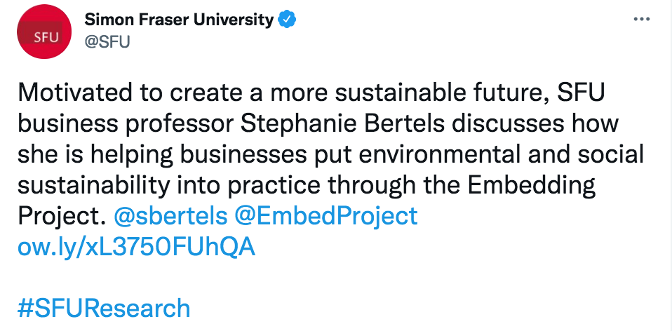Twitter for Academics: Your Starter Guide

Did you miss the Knowledge Mobilization Hub’s Twitter for Academics webinar? Never fear! In this post, I’ll build on the expertise shared by SFU’s Ian Young and Scott Lear and other Twitter pros that I follow. Read on for your starter guide to the why, how, and what ifs of Twitter for researchers.
Why? Top 7 reasons to start using Twitter
- Make your research more accessible, across disciplines, sectors, and to the public. Most research is publicly funded, and you work hard to make it happen. Sharing your work on Twitter means more people will see it.
- Contribute to dispelling mis/disinformation. You’ve likely heard that we’re in an infodemic. That doesn’t mean you should not contribute more information – it means we need to do our part to contribute and boost good information.
- Network. Amplify your work and reputation and become known in your niche. This can lead to more invitations for collaborations, speaking engagements, funding, and recognition of your expertise.
- Build awareness about issues, needs, concerns, and opportunities. Twitter can serve as a starting place for getting issues you care about on decision makers’ radar.
- Inspire action. Inform policy, practice, research – the more people know about the issue, your work, and expertise, the more opportunity you have to contribute to positive change.
- Learn. Follow accounts, topics, people that interest you within and beyond your discipline – stay up to date, informed, and engaged.
- Recruit (students, staff, study participants). Share your opportunities widely and increase your pool of potential applicants.
How? Three steps for getting started on Twitter
Step 1: Build a community of followers
To get the results you want (see above) you need to have followers. It’s generally understood that once you have over 1000 followers, your posts will extend your reach beyond your bubble. Don’t get discouraged! Everyone starts with 0 followers.
Here are five tips for building your Twitter network:
- Follow people in your area of interest
- Follow SFU official Twitter accounts, and other organizations in your discipline
- Respond to and share tweets of the accounts you follow - try to include a message, thought, or analysis about what you are retweeting
- Include calls to action in your tweets (e.g. ask questions, direct to other content)
- Post regularly – aim for 1-3 engagements per day (retweets, comments, and your content).
Step 2: Make it your own
Create a personal brand, or “look and feel” of your Twitter account. Start by identifying your goals for using Twitter, the audience and stakeholders you hope to reach, and the conversations you want to have. Now go ahead and create your Twitter profile! You will need:
- A memorable & relevant handle e.g. @heysciencesam
- A professional profile picture and relevant cover photo (if you are on multiple platforms, consider using the same images for consistency and easy recognition)
- An informative and succinct bio
- When crafting your tweets, consider your tone. People prefer to engage with tweets that are brief, creative, personable, honest, engaging, timely, relevant, and conversational. You won’t be an expert at this right away! Writing tweets takes practice. The more you tweet, the more you’ll get in touch with your “Twitter voice.”
- Consider using images, videos, links – they can grab attention
- Consider using # hashtags to connect to topics, events, themes (e.g. #COVID19) and @ to connect people (e.g. @lupinrain) to the conversation

Step 3: Make it accessible
While the internet can increase accessibility in many ways, it can also exclude people. There are some simple ways to combat this by making every post as accessible as possible. Here are some practical strategies for creating accessible Twitter content:
- Use image descriptions
- Limit emoji and emoticon use
- Use CamelCase for multi-word hashtags (e.g. #KnowledgeMobilization #ResearchImpact). Why? See this Pickle Jar blog post
- Place hashtags and mentions at the end of post
- Don’t embed text in images
- Use link-shortening services
- Follow plain language principles
- Avoid ableist, sexist, and racist language
- See Twitter for more accessibility tips

What ifs? Common concerns about using Twitter and how to deal with them
While I’m hoping that you are excited about getting started with Twitter, I want to take a moment to acknowledge some of the challenges you might face in this online space as well.
Trolls & negative comments
If you are covering a controversial topic or use a controversial tone, particularly if you are from an equity deserving group, there is the potential that responses to your tweets might be negative, rude, offensive, or hurtful. Protect yourself by reviewing your privacy and security options and set them accordingly: e.g., you can turn off direct messaging and block questionable or aggressive commenters. If a negative comment is worthy of response – perhaps because you want to correct misinformation – use a friendly, professional, and sincere manner.
Feeling exposed
Twitter is a public space. Be selective and intentional, and only share what you are comfortable sharing. You can dip your toe in and see how it goes, and if it doesn’t work for you, choose to stop at any point. If you aren’t comfortable with a personal account, you can use a Twitter account for your lab or research group instead, using your lab logo and information for the profile (e.g. @chatrlab).
Saying the wrong thing
This will likely happen, and that is okay. Stay humble. For example, if you use language that is ableist and you are called out for it, acknowledge your mistake, learn from it, and adjust your language next time.
It’s a time suck
We all have gone down the social media rabbit hole one time or another! This may happen for your academic Twitter account too. If you are at risk of getting sucked in, then set a timer, block Twitter time into your schedule, or otherwise set limits and structures that will protect your time. There are also a number of Twitter tools that can help.
Need some inspiration?
Check out these academic Twitter accounts:
- Alice Fleerackers, writer, digital journalism and science communication researcher, and SFU PhD candidate.
- Hannah McGregor, podcaster, teacher, feminist, and SFU professor
- Lynne Quarmby, climate watcher, snow algae researcher, and SFU professor
- Scott Lear, prevention of heart disease, advocate, and SFU and PHSA professor
- Kimberlé Crenshaw, Executive director, podcaster, on intersectionality and critical race theory, and Columbia Law and UCLA professor
- Tim Caulfield, Professor of health law & science policy, speaker, TV host & author
- Science Sam, Science Communicator with a PhD in cell and molecular biology and neuroscience
Learn more
Read Social Media Survival Guide for Scientists by Science.
Not convinced you should share your research on social media? See what others are saying, read Researchers are the New Influencers by engadget. And this blog post by Massive Science on the power of social media
Originally published by Lupin Battersby


